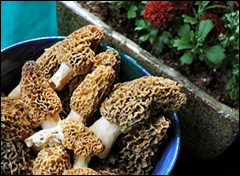
Here in Iowa, the farmers markets are just emerging from hibernation, and with them the CSAs. Community-supported agriculture is not a new idea, but it certainly has been gaining ground over the past few years as ideas such as “local” and “sustainable” migrate from the fringes to the center.
For the uninitiated, CSAs operate a lot like magazine subscriptions. You find one whose content you like, pay your money up front, and receive weekly allotments of fresh local produce, dairy, eggs, flowers, and sometimes meat. CSAs offer a great way to “go local,” and they present you with new surprises each week throughout the growing season (which around here is about 20 weeks long).
At least as important is the mutual assumption of risk. The farmer gets a cash infusion before the season starts when s/he really needs it, and if there’s a flood or a drought or a swarm of locusts, the farmer and the CSA members share the loss the same way they would share the bounty if it were all to go a better way.
So it is that community supports agriculture. But when it’s done well, it should perhaps be more aptly titled agriculture-supported community. It supplies something we all need — fresh, wholesome food — while also bringing people together. CSAs strengthen it in a way that cannot be measured up close. One needs to stand back to see it.
Little by little as I have watched our older CSAs grow and seen new ones emerge, more and more people are delighting in the rewards. More children are growing up healthy; more farmers are making a living growing actual food, not industrial inputs; fewer fields are getting pounded with life-destroying agrichemicals; more wealth is building within communities.
Yet CSAs still represent a relatively small portion of agriculture in Iowa. Their success makes me think about what would happen if they spread. I live in a county, Johnson, with 46,000 households. Imagine what would happen if each of those households redirected just $10 of their existing weekly food budget toward buying something produced locally. We’d see nearly $24M stay here in our community rather than disappear to Little Rock never to be seen again. Just think of all the potholes from our harsh winter we could fix for that, to say nothing of the schools we could build or the diesel that wouldn’t be burnt.
My restaurant buys two full CSA shares. Kim and I skim a little off the top to take home and the rest gets used for specials as long as it lasts. My cooks love it because they get the challenge of working with something new, and my guests love it because they know it came from right down the road.
Some local produce has already begun to arrive. We have scads of spinach from local urban agriculture pioneer Derek Roller, who converted his center-city yard into one of the most prolific gardens I’ve seen. His produce will keep us in local greens until the stuff Kim planted in our own gardens catches up. That is, of course, unless we’re hit hard by the frost they’re predicting for tonight. Dicey thing, agriculture.

Greens party.
Grilled Cheese/Spinach Sandwiches
Just last night Kim and I put some of Derek’s spinach to good use in our usual glorified ham’n’cheese sammies and improved upon perfection. Here’s how we did it:
4 thick slices of mozzarella (we use a local organic one from Kalona)
4-6 leaves of fresh spinach, washed, stems removed
4 slices ham from local pastured hogs (I’m lucky enough that La Quercia prosciutto is my local ham; try to find a source of artisan-style ham in your area)
2 tablespoons bacon fat, butter, or olive oil
Build the 2 sandwiches in this order: slice of bread, slice of cheese, spinach, meat (if desired), other slice of cheese, other slice of bread.
Heat your choice of fat in a skillet over medium-high heat. Place the sandwiches in the pan, and allow the bread to brown (about 2-3 minutes). Turn once, wait one minute, cover and remove from heat. Let stand about 3 minutes, until the cheese is melted, and serve immediately.
Serves 2.


